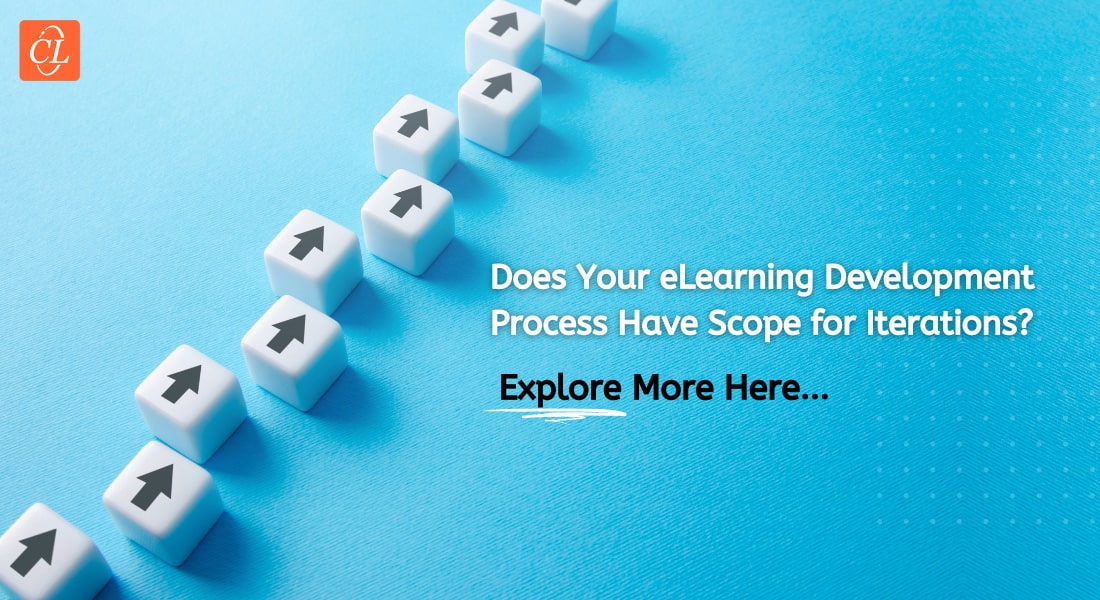Beginner’s Guide to eLearning Design & Development

Contemplating adopting eLearning for your corporate training and development? First: we would like to congratulate you on this futuristic decision. Secondly: We would like to tell you to be very careful with the design & development of your eLearning project. This article will help you do it right.
Most eLearning projects fail because the teams responsible for their design and development fail to get the process right. But don’t you worry, we are here to help. This article will discuss in detail the process of eLearning design and development based on the Successive Approximations Model (SAM).
Want to Design a High-Performance eLearning Solution?
If yes, here are the 3 key stages in the process:
- Preparation
- Iterative Design
- Iterative Development
The Process of eLearning Design & Development
Ideally, the process involves three stages:
- Preparation
- Iterative Design
- Iterative Development
Stage 1: Preparation
This is the planning stage where you will have to set goals (what do you want to achieve from the course), plan the formats to be included, and decide on the authoring tools and the Graphical User Interface (GUI).
You will have to gather all the relevant information and content required for the eLearning course/ project. This background information will help in preparing well for the project.
During the preparation stage:
Identify Business Challenges & Goals
The core idea behind corporate training is to make sure that it contributes to solving the challenges faced by an organization. For instance, you may choose to train your marketing teams in a new market that is complex to tap into.
Keeping this in mind, you should start by identifying the business goals and the challenges. By doing this, you can take decisions around these challenges and goals.
Identify your Target Audience
Knowing who your target audience is, will help you develop the course objectives, the tone to be used, the instructional design strategy, the format, etc.
To identify the target audience for corporate training, you need to identify the specific people who need to be trained, the purpose of the course, their background, and their prior knowledge of the topic.
Set the Learning Objectives
Based on the business challenges and goals, and the target audience, you will have to decide on the learning objectives. By deciding on the learning objectives, you can filter the course content and include only the content that is relevant. Additionally, the objectives also help in deciding the instructional design strategy and the evaluation methods to be included.
Decide on the Technicalities
Based on the type of training, the target audience, timelines of the course, etc, you need to decide on the most suitable authoring tool to go forward. At the same time, you should also finalize the best Graphic User Interface (GUI) where the learners can access the course. When deciding on the GUI, you should ensure that the GUI is in sync with your organization’s branding (colors, logo, etc.), and is intuitive enough to guide the learners.
Decide on the Delivery Strategy
The preparation stage also involves deciding on the instructional design strategy, i.e., the high-level plan to decide how the course/ topic should be taught. This step includes deciding on the instruction methods, techniques, devices to be used, and also assessment strategies.
Some of the popular Instructional Design strategies include guided learning, case studies, storytelling, scenario-based learning, and game-based learning.
Get to know the best instructional design strategies to design engaging eLearning courses
Stage 2: Iterative Design
While we have planned and decided on the Instructional Design during the Preparation Stage, the selected high-level strategy will be finalized during this stage. Upon finalizing, your Instructional Design (ID) team should start working on a prototype. The prototype must be designed using the authoring tool selected in the Preparation Stage, and 5 to 10 slides of content gathered.
With the prototype in hand, you will get a fair idea of the entire project – its look, feel, and also the functionality. Based on the prototype, you will also be able to improve or make changes to the project if required.
Stage 3: Iterative Development
Once the prototype is finalized, the design and development team gets into the process of building the entire project.
This will include:
- Developing the storyboard for the entire course content. This is done using the strategy and visual design that was used for the prototype. A storyboard is a visual representation of the shot-by-shot progression of your video – eLearning content. Every shot (illustration slide) comprises a visual, along with comments describing what is happening in the scene and what is being conveyed in the script at that time.
- Upon the development and approval of the storyboard, the teams need to build the functional course, without audio. This has to be sent, along with the audio script, to the client for approval. This is called the Alpha version.
- Once the Alpha version is approved, the Beta version i.e., the functional course integrated with audio, is sent for approval.
- Once the Beta version is approved, the course developed is tested on LMS – Learning Management System before uploading it. This is called the Gold Version.
The final course is tested for SCORM/AICC/TinCan compatibility.
Technical Standards to Test the eLearning Course Developed
The eLearning course developed should be compatible with the following technical standards:
AICC: The Aviation Industry Computer-Based Training Committee (AICC) is credited for creating the first learning standards for eLearning. This technical standard provides guidance for developing, delivering, and evaluating training material across computer-based training platforms.
SCORM: The Sharable Content Object Reference Model (SCORM) can be defined as a set of eLearning standards to address reusability, interoperability, and durability – the main challenges with online learning initiatives.
SCORM-compliant eLearning solution is embedded with a JavaScript Application Programming Interface (JS API). This will ensure that the learning content can work properly on an LMS.
Tin Can: Also known as the Experience API (xAPI), the Tin Can API, helps the learning content and the learning management systems to interact and store all the data about the user’s learning experience.
Along with the benefits of SCORM, Tin Can also offers better security, cross-domain connectivity, LMS independence, multiple score reporting, and advanced portability.
Wrapping Up
In this article, we have discussed the three key stages involved in the design and development of an eLearning course. The SAM model serves as the perfect framework for designing and developing a high-performance eLearning solution. However, it is important to understand that no two online learners are the same and so are their learning needs and preferences.
Therefore, it is also crucial that you have the necessary knowledge and understanding of your target audience and their needs. Want to become more aware of your target audience, and learn more about the nuances in eLearning? This eBook could be foundational for you. Grab your copy now and get set go on the path of becoming an eLearning Champion!





